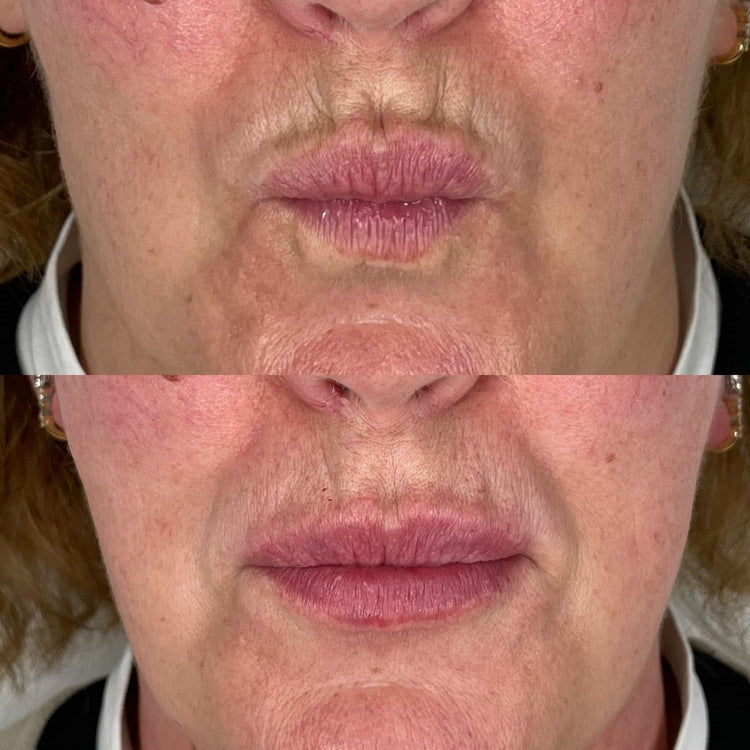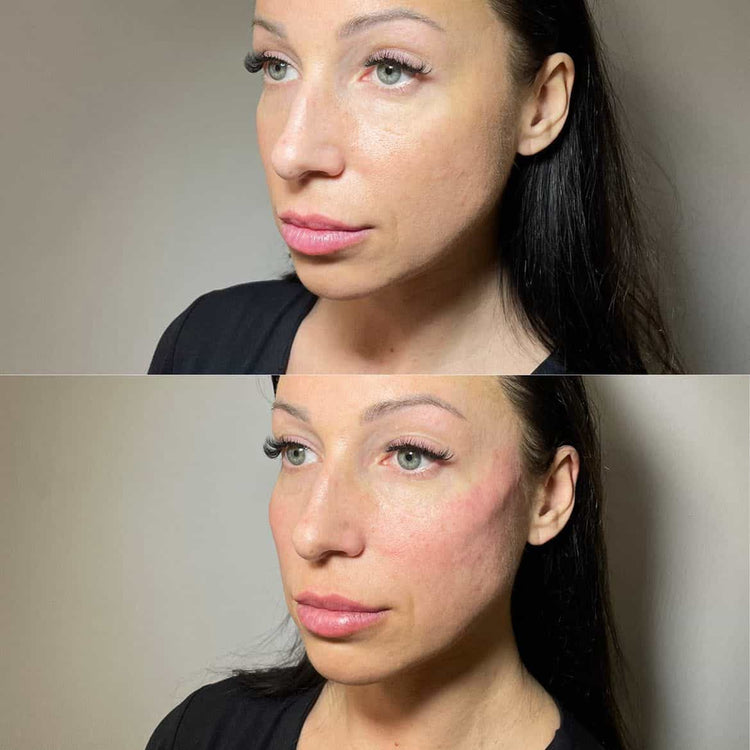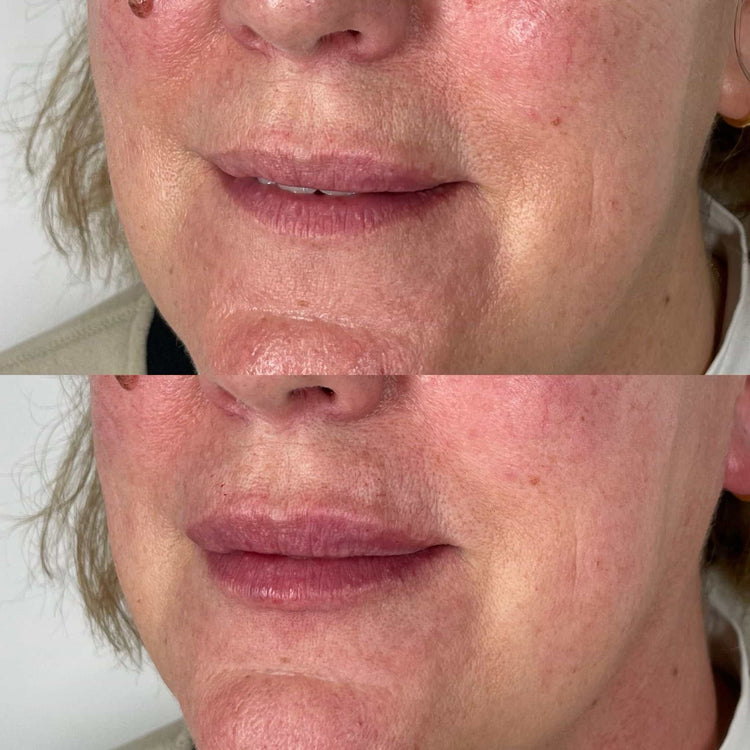Dermal Fillers
Dermal fillers have become increasingly popular in recent years, offering a non-surgical approach to enhance facial features and restore youthful contours. These injectable gels, typically made from hyaluronic acid, are carefully placed beneath the skin to add volume, smooth wrinkles, and create a more balanced and harmonious appearance.
What Are Dermal Fillers?
Hyaluronic acid is a naturally occurring substance in the body that helps maintain skin hydration and elasticity. Dermal fillers leverage this property by injecting a gel-like form of hyaluronic acid into specific areas of the face.
This added volume can plump up lips, reduce the appearance of fine lines and wrinkles, and redefine facial contours such as cheekbones or jawlines.
The results from dermal filler injections are typically visible immediately and can last anywhere from several months to over a year, depending on the type of filler used and individual factors like metabolism.
Types of Dermal Fillers
Dermal fillers have become increasingly popular in recent years, offering a non-surgical approach to enhance facial features and restore youthful contours. These injectable gels, typically made from hyaluronic acid, are carefully placed beneath the skin to add volume, smooth wrinkles, and create a more balanced and harmonious appearance.
Hyaluronic acid is a naturally occurring substance in the body that helps maintain skin hydration and elasticity. Dermal fillers leverage this property by injecting a gel-like form of hyaluronic acid into specific areas of the face.
This added volume can plump up lips, reduce the appearance of fine lines and wrinkles, and redefine facial contours such as cheekbones or jawlines.
The results from dermal filler injections are typically visible immediately and can last anywhere from several months to over a year, depending on the type of filler used and individual factors like metabolism.
There are various types of dermal fillers available, each with unique properties and applications:
- Hyaluronic Acid Fillers: The most common type, these fillers provide temporary volume and hydration. They can be used for a variety of purposes, such as lip augmentation, wrinkle reduction, and cheek enhancement.
- Poly-L-Lactic Acid (PLLA) Fillers: These fillers stimulate collagen production, gradually adding volume over time. Results typically last longer than hyaluronic acid fillers.
- Calcium Hydroxylapatite Fillers: These fillers are biocompatible and designed to provide a more structured lift. They can be used to address deeper wrinkles and contouring needs.
How Dermal Fillers Work
Dermal fillers have become increasingly popular in recent years, offering a non-surgical approach to enhance facial features and restore youthful contours. These injectable gels, typically made from hyaluronic acid, are carefully placed beneath the skin to add volume, smooth wrinkles, and create a more balanced and harmonious appearance.
Hyaluronic acid is a naturally occurring substance in the body that helps maintain skin hydration and elasticity. Dermal fillers leverage this property by injecting a gel-like form of hyaluronic acid into specific areas of the face.
This added volume can plump up lips, reduce the appearance of fine lines and wrinkles, and redefine facial contours such as cheekbones or jawlines.
The results from dermal filler injections are typically visible immediately and can last anywhere from several months to over a year, depending on the type of filler used and individual factors like metabolism.
There are various types of dermal fillers available, each with unique properties and applications:
- Hyaluronic Acid Fillers: The most common type, these fillers provide temporary volume and hydration. They can be used for a variety of purposes, such as lip augmentation, wrinkle reduction, and cheek enhancement.
- Poly-L-Lactic Acid (PLLA) Fillers: These fillers stimulate collagen production, gradually adding volume over time. Results typically last longer than hyaluronic acid fillers.
- Calcium Hydroxylapatite Fillers: These fillers are biocompatible and designed to provide a more structured lift. They can be used to address deeper wrinkles and contouring needs.
Facial Symmetry and Beauty Standards
Throughout history, symmetrical facial features have been associated with beauty standards across various cultures. A balanced and harmonious appearance is often perceived as attractive, leading to a desire to enhance or correct perceived asymmetries.
The Perception of Facial Harmony

Throughout history, symmetrical facial features have been associated with beauty standards across various cultures. A balanced and harmonious appearance is often perceived as attractive, leading to a desire to enhance or correct perceived asymmetries.
This perception of symmetry stems from evolutionary psychology, where it was linked to indicators of good health and genetic fitness. The human brain naturally seeks patterns and order, finding symmetrical faces more pleasing to the eye due to their inherent sense of balance.
While perfect symmetry is rare in nature, deviations that are subtle can often be imperceptible to the casual observer. However, more pronounced asymmetries can draw attention and potentially detract from perceived attractiveness.
Common Facial Asymmetries
Throughout history, symmetrical facial features have been associated with beauty standards across various cultures. A balanced and harmonious appearance is often perceived as attractive, leading to a desire to enhance or correct perceived asymmetries.
This perception of symmetry stems from evolutionary psychology, where it was linked to indicators of good health and genetic fitness. The human brain naturally seeks patterns and order, finding symmetrical faces more pleasing to the eye due to their inherent sense of balance.
While perfect symmetry is rare in nature, deviations that are subtle can often be imperceptible to the casual observer. However, more pronounced asymmetries can draw attention and potentially detract from perceived attractiveness.
Common facial asymmetries include differences in eyebrow height, nostril size, lip fullness, or ear positioning. These variations can occur naturally due to genetics or factors during development.
Using Fillers to Enhance Facial Symmetry
Throughout history, symmetrical facial features have been associated with beauty standards across various cultures. A balanced and harmonious appearance is often perceived as attractive, leading to a desire to enhance or correct perceived asymmetries.
This perception of symmetry stems from evolutionary psychology, where it was linked to indicators of good health and genetic fitness. The human brain naturally seeks patterns and order, finding symmetrical faces more pleasing to the eye due to their inherent sense of balance.
While perfect symmetry is rare in nature, deviations that are subtle can often be imperceptible to the casual observer. However, more pronounced asymmetries can draw attention and potentially detract from perceived attractiveness.
Addressing Specific Asymmetries

Throughout history, symmetrical facial features have been associated with beauty standards across various cultures. A balanced and harmonious appearance is often perceived as attractive, leading to a desire to enhance or correct perceived asymmetries.
This perception of symmetry stems from evolutionary psychology, where it was linked to indicators of good health and genetic fitness. The human brain naturally seeks patterns and order, finding symmetrical faces more pleasing to the eye due to their inherent sense of balance.
While perfect symmetry is rare in nature, deviations that are subtle can often be imperceptible to the casual observer. However, more pronounced asymmetries can draw attention and potentially detract from perceived attractiveness.
Common facial asymmetries include differences in eyebrow height, nostril size, lip fullness, or ear positioning. These variations can occur naturally due to genetics or factors during development.
Dermal fillers offer a non-surgical solution to address these asymmetries and create a more balanced appearance. By strategically injecting filler into areas that need augmentation or contouring, practitioners can subtly enhance facial features and minimize the appearance of imbalances.

For example, if one side of the face appears droopy due to volume loss in the cheekbones, dermal filler can be used to add volume and lift the cheek on the weaker side, restoring symmetry.
Similarly, fillers can address unevenness in lip fullness or create a more symmetrical smile by subtly plumping up areas that need enhancement.
It is important to note that achieving facial symmetry with fillers is a delicate process that requires expertise and careful assessment. A qualified injector will consider the individual’s facial structure, anatomy, and desired outcome to develop a personalized treatment plan.
Creating Balance Through Subtle Adjustments
Dermal fillers have become increasingly popular in recent years, offering a non-surgical approach to enhance facial features and restore youthful contours. These injectable gels, typically made from hyaluronic acid, are carefully placed beneath the skin to add volume, smooth wrinkles, and create a more balanced and harmonious appearance.
Hyaluronic acid is a naturally occurring substance in the body that helps maintain skin hydration and elasticity. Dermal fillers leverage this property by injecting a gel-like form of hyaluronic acid into specific areas of the face.
This added volume can plump up lips, reduce the appearance of fine lines and wrinkles, and redefine facial contours such as cheekbones or jawlines.
The results from dermal filler injections are typically visible immediately and can last anywhere from several months to over a year, depending on the type of filler used and individual factors like metabolism.
Throughout history, symmetrical facial features have been associated with beauty standards across various cultures. A balanced and harmonious appearance is often perceived as attractive, leading to a desire to enhance or correct perceived asymmetries.
This perception of symmetry stems from evolutionary psychology, where it was linked to indicators of good health and genetic fitness. The human brain naturally seeks patterns and order, finding symmetrical faces more pleasing to the eye due to their inherent sense of balance.
While perfect symmetry is rare in nature, deviations that are subtle can often be imperceptible to the casual observer. However, more pronounced asymmetries can draw attention and potentially detract from perceived attractiveness.
Common facial asymmetries include differences in eyebrow height, nostril size, lip fullness, or ear positioning. These variations can occur naturally due to genetics or factors during development.
Dermal fillers offer a non-surgical solution to address these asymmetries and create a more balanced appearance. By strategically injecting filler into areas that need augmentation or contouring, practitioners can subtly enhance facial features and minimize the appearance of imbalances.
For example, if one side of the face appears droopy due to volume loss in the cheekbones, dermal filler can be used to add volume and lift the cheek on the weaker side, restoring symmetry.
Similarly, fillers can address unevenness in lip fullness or create a more symmetrical smile by subtly plumping up areas that need enhancement.
It is important to note that achieving facial symmetry with fillers is a delicate process that requires expertise and careful assessment. A qualified injector will consider the individual’s facial structure, anatomy, and desired outcome to develop a personalized treatment plan.
Considerations for Treatment
Dermal fillers have become increasingly popular in recent years for their ability to subtly enhance facial features and restore balance to the face. Achieving facial symmetry is often desired as it is perceived as more aesthetically pleasing.
Consultation and Assessment
When considering dermal fillers for facial symmetry enhancement, several crucial factors must be taken into account:
* **Consultation and Assessment:** A thorough consultation with a qualified injector is essential. This involves a detailed discussion of the patient’s goals, medical history, and any existing concerns. The injector will assess the patient’s facial anatomy, identify areas needing correction, and determine the most appropriate type and volume of filler to achieve the desired outcome.
* **Treatment Plan:** Based on the assessment, the injector will develop a personalized treatment plan outlining the specific injection points, techniques, and expected results. It is crucial for patients to understand the procedure, potential risks and benefits, and realistic expectations before making a decision.
* **Experience and Qualifications:** Choosing an experienced and qualified injector is paramount. Look for a practitioner with extensive training and experience in facial aesthetics, particularly in using dermal fillers for symmetry correction.
* **Type of Filler:** Different types of dermal fillers have varying properties and durations of effect. The injector will select the most suitable filler based on the individual’s needs and desired outcome.
* **Realistic Expectations:** It is important to have realistic expectations about what can be achieved with dermal fillers. While they can significantly enhance facial symmetry, they cannot completely correct severe asymmetries or achieve perfect symmetry.
Open communication between the patient and injector throughout the process is vital for ensuring a safe and successful outcome.
Choosing the Right Filler Type
When choosing the right dermal filler type, several factors should be considered:
- Desired Outcome:
- Duration of Effect:
- Consistency and Spreadability:
- Patient’s Skin Type and Concerns:
What specific areas need correction? Are you looking to add volume, smooth wrinkles, or define contours?
Some fillers last longer than others. Hyaluronic acid fillers typically last 6-18 months, while poly-L-lactic acid (PLLA) fillers can last for up to two years.
The consistency of a filler determines how easily it spreads under the skin. Some fillers are thicker and more structured, ideal for contouring, while others are thinner and more fluid, better suited for smoothing wrinkles.
An experienced injector will consider factors like skin elasticity, thickness, and any allergies or sensitivities when selecting the most appropriate filler type.
Treatment Procedure and Risks
Before undergoing dermal filler treatment for facial symmetry, potential risks and complications should be carefully considered:
Common Side Effects:
Most side effects from dermal fillers are mild and temporary, typically resolving within a few days to weeks. These can include bruising, swelling, redness, tenderness, itching, or small bumps at the injection site.
Serious Complications (Less Common):
While rare, some more serious complications can occur, such as:
- Allergic Reactions:
- Infection:
- Vascular Occlusion:
- Asymmetry: **
- Granuloma Formation: **
Although uncommon, allergic reactions to the filler ingredients can happen.
Any injection procedure carries a risk of infection if proper sterilization techniques are not followed.
This occurs when a blood vessel is blocked by the filler, potentially leading to tissue damage or necrosis (death). It is crucial to avoid injecting filler into areas close to major blood vessels.
Even with experienced injectors, achieving perfect symmetry can be challenging. There’s always a risk of one side looking different from the other.
This is a small lump that forms as the body reacts to the filler material.
It is essential to consult with a qualified and experienced injector who can assess your individual needs, discuss potential risks, and ensure safe and effective treatment.
Choosing an accredited clinic or practice with appropriate licensing and sterile procedures further minimizes the risk of complications.
Long-Term Results and Maintenance
Dermal fillers offer a promising approach to enhance facial symmetry, but it’s crucial to understand that maintaining the results requires ongoing care and attention.
Replenishment Treatments:
As dermal fillers are temporary, repeat treatments are necessary to maintain the desired aesthetic outcome. The frequency of these touch-up appointments varies depending on the type of filler used, individual metabolism, and lifestyle factors. Typically, follow-up sessions are scheduled every 6 to 18 months.
Lifestyle Factors:
Certain habits can impact the longevity of dermal filler results. Protecting your skin from sun exposure through the use of sunscreen is essential as UV rays can break down hyaluronic acid, leading to premature filler degradation.
Smoking and excessive alcohol consumption can also affect collagen production and contribute to faster filler breakdown.
Maintaining a healthy lifestyle with a balanced diet, adequate hydration, and sufficient sleep supports overall skin health and helps preserve the long-term effects of dermal fillers.
Discover how dermal fillers can enhance your facial beauty at It’s Me & You Clinic
- Why Do I Look Like Maleficent After Cheek Fillers? - November 17, 2025
- What Is The Best Nonsurgical Facelift? - November 15, 2025
- What Are The Best CBD Gummies For Managing Anxiety? - November 14, 2025
